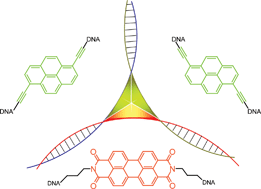 The naturally occurring 3-way junction formed at the branch point of three DNA or RNA strands is a useful structure for organising functional molecules. In this hot paper Markus Probst et al. have used the three-way junction to assemble non-nucleosidic alkynylpyrene and perylenediimide chromophores at the branch point area. The spectroscopic properties of the chromophores can be modified depending on the composition of the DNA junction, ranging from monomer or excimer fluorescence to complete quenching, demonstrating the potential of such assemblies for use in diagnostic, electronic, optical and mechanical applications
The naturally occurring 3-way junction formed at the branch point of three DNA or RNA strands is a useful structure for organising functional molecules. In this hot paper Markus Probst et al. have used the three-way junction to assemble non-nucleosidic alkynylpyrene and perylenediimide chromophores at the branch point area. The spectroscopic properties of the chromophores can be modified depending on the composition of the DNA junction, ranging from monomer or excimer fluorescence to complete quenching, demonstrating the potential of such assemblies for use in diagnostic, electronic, optical and mechanical applications
Read more…..
The DNA three-way junction as a mould for tripartite chromophore assembly
Markus Probst, Daniel Wenger, Sarah M. Biner and Robert Häner
DOI: 10.1039/C1OB06400B

